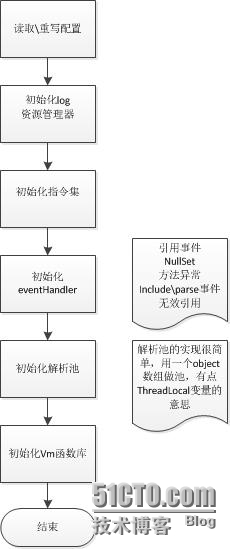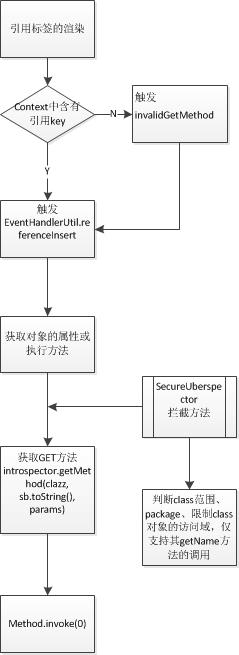velocity的标签中支持$abc 这样的语法,如果abc是一个对象,则写模板时就可以利用它来进行反射,调用一些危险的方法,如
$vm.getClass().newInstance()
#set ($exec = "kxlzx")$exec.class.forName("java.lang.Runtime").getRuntime().exec("calc")
通过反射,让系统本身出现了安全漏洞,这类危险的操作,可以通过屏蔽反射来杜绝,在velocity属性中添加一行配置即可
runtime.introspector.uberspect = org.apache.velocity.util.introspection.SecureUberspector
velocity默认的配置为:
runtime.introspector.uberspect = org.apache.velocity.util.introspection.UberspectImpl
本文主要讨论从velocity初始化过程到解析标签。以及如何通过
SecureUberspector
来屏蔽反射,欢迎补充。
velocity的内省主要的用处是解析如$a.id,$a.name的引用,与其说是内省,不如说是通过反射找get方法。。。。
关于内省的概念 传送门:http://www.cnblogs.com/peida/archive/2013/06/03/3090842.html
先来分析velocity的初始化过程
这里只是对velocity初始化过程的概括,初始化过程大量依赖的配置参数,即velocity.properties,用户一般自定义该文件或直接载入Properties,默认的配置目录为
org/apache/velocity/runtime/defaults/velocity.properties
调用方法渲染流程
VelocityEngine velocityEngine = new VelocityEngine("/velocity.properties");
velocityEngine.evaluate(context, writer, "logMsgName", new InputStreamReader(VelocityTest2.class.getResource("test.vm").openStream()));
生成NodeTree的代码比较复杂,可能用的是某种算法,总之,最后的Tree里面包含了所有的vm信息,如果是parse\include会生成AsTDirective,如果是文本,会生成ASTText对应,如果是set,会生成ASTSetDirective,如果是引用,会生成ASTReference对应。。等等。。
这里列举几个标签的处理流程
parse
从源代码分析来看,parse标签里面的内容甚至可以写成动态的,如
#parse("${a}.vm")
发送includeEvent和velocity初始化过程中的各个事件处理器是对应的,引入vm文件外的文件,都会触发includeEvent,然后根据其返回值,来找到真正的vm资源文件,因此,我们可以在eventHander中重定向返回的资源位置,如 a.vm -> b.vm
另外,parse和include 对velocity来说,是两种type,解析parse文件时,会把context传入进行解析
引用标签,如$a,$vm.id
普通的引用渲染流程不包括子流程 “SecureUberspector拦截方法”,如果引用值为$a.id ,则会去找a.getid() -> a.getId(),,然后反射调用method.invoke(objecct)
引用的渲染流程会根据identifier和method进行不同的流程
identifier方式即$a.id
method方式即$a.println()
为什么下面两行嗲吗的效果一样呢
$exec.class $exec.getClass()
原因就在这里,velocity把class当成一个属性来处理了,因此,去找getClass方法,恰好对象都有getClass方法,这样效果就和直接写$exec.getClass()一样了
SecureUberspector如果达到屏蔽反射方法的呢,先来看一看它的类依赖
UberspecttImpl中有一个introspector对象,SecureUberspector对其进行了重定义SecureUberspector的初始化方法如下,badPackages和badClass的配置也是在默认的velocity.properties中配置的,用户可以添加更多的配置
public void init()
{
String [] badPackages = runtimeServices.getConfiguration()
.getStringArray(RuntimeConstants.INTROSPECTOR_RESTRICT_PACKAGES);
String [] badClasses = runtimeServices.getConfiguration()
.getStringArray(RuntimeConstants.INTROSPECTOR_RESTRICT_CLASSES);
introspector = new SecureIntrospectorImpl(badClasses, badPackages, log);
}
SecureIntrospectorImpl实现了方法
public Method getMethod(Class clazz, String methodName, Object[] params)
throws IllegalArgumentException
{
if (!checkObjectExecutePermission(clazz, methodName))
{
log.warn("Cannot retrieve method " + methodName +
" from object of class " + clazz.getName() +
" due to security restrictions.");
return null;
}
else
{
return super.getMethod(clazz, methodName, params);
}
}
/**
* Determine which methods and classes to prevent from executing. Always blocks
* methods wait() and notify(). Always allows methods on Number, Boolean, and String.
* Prohibits method calls on classes related to reflection and system operations.
* For the complete list, see the properties <code>introspector.restrict.classes</code>
* and <code>introspector.restrict.packages</code>.
*
* @param clazz Class on which method will be called
* @param methodName Name of method to be called
* @see org.apache.velocity.util.introspection.SecureIntrospectorControl#checkObjectExecutePermission(java.lang.Class, java.lang.String)
*/
public boolean checkObjectExecutePermission(Class clazz, String methodName)
{
/**
* check for wait and notify
*/
if (methodName != null &&
(methodName.equals("wait") || methodName.equals("notify")) )
{
return false;
}
/**
* Always allow the most common classes - Number, Boolean and String
*/
else if (Number.class.isAssignableFrom(clazz))
{
return true;
}
else if (Boolean.class.isAssignableFrom(clazz))
{
return true;
}
else if (String.class.isAssignableFrom(clazz))
{
return true;
}
/**
* Always allow Class.getName()
*/
else if (Class.class.isAssignableFrom(clazz) &&
(methodName != null) && methodName.equals("getName"))
{
return true;
}
/**
* check the classname (minus any array info)
* whether it matches disallowed classes or packages
*/
String className = clazz.getName();
if (className.startsWith("[L") && className.endsWith(";"))
{
className = className.substring(2, className.length() - 1);
}
int dotPos = className.lastIndexOf('.');
String packageName = (dotPos == -1) ? "" : className.substring(0, dotPos);
for (int i = 0, size = badPackages.length; i < size; i++)
{
if (packageName.equals(badPackages[i]))
{
return false;
}
}
for (int i = 0, size = badClasses.length; i < size; i++)
{
if (className.equals(badClasses[i]))
{
return false;
}
}
return true;
}
SecureIntrospectorImpl
这里可以看见它对对象访问方法的屏蔽操作
badPackage:java.lang.refect
badClass:
那么,为什么我们不直接使用SecureIntrospectorImpl呢,因为它仅仅是一个工具
SecureUberspector类对foreach标签也进行了支持
/**
* Get an iterator from the given object. Since the superclass method
* this secure version checks for execute permission.
*
* @param obj object to iterate over
* @param i line, column, template info
* @return Iterator for object
* @throws Exception
*/
public Iterator getIterator(Object obj, Info i)
throws Exception
{
if (obj != null)
{
SecureIntrospectorControl sic = (SecureIntrospectorControl)introspector;
if (sic.checkObjectExecutePermission(obj.getClass(), null))
{
return super.getIterator(obj, i);
}
else
{
log.warn("Cannot retrieve iterator from " + obj.getClass() +
" due to security restrictions.");
}
}
return null;
}
就这样,foreach时,如果对象是java.lang.refect包下的类或badClass,就没有权限了










